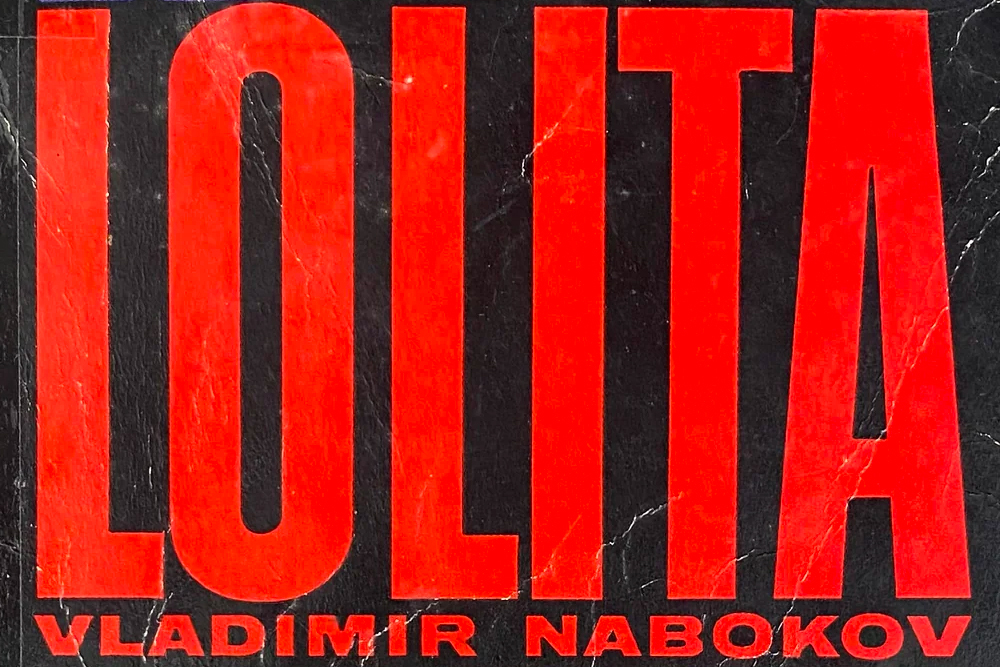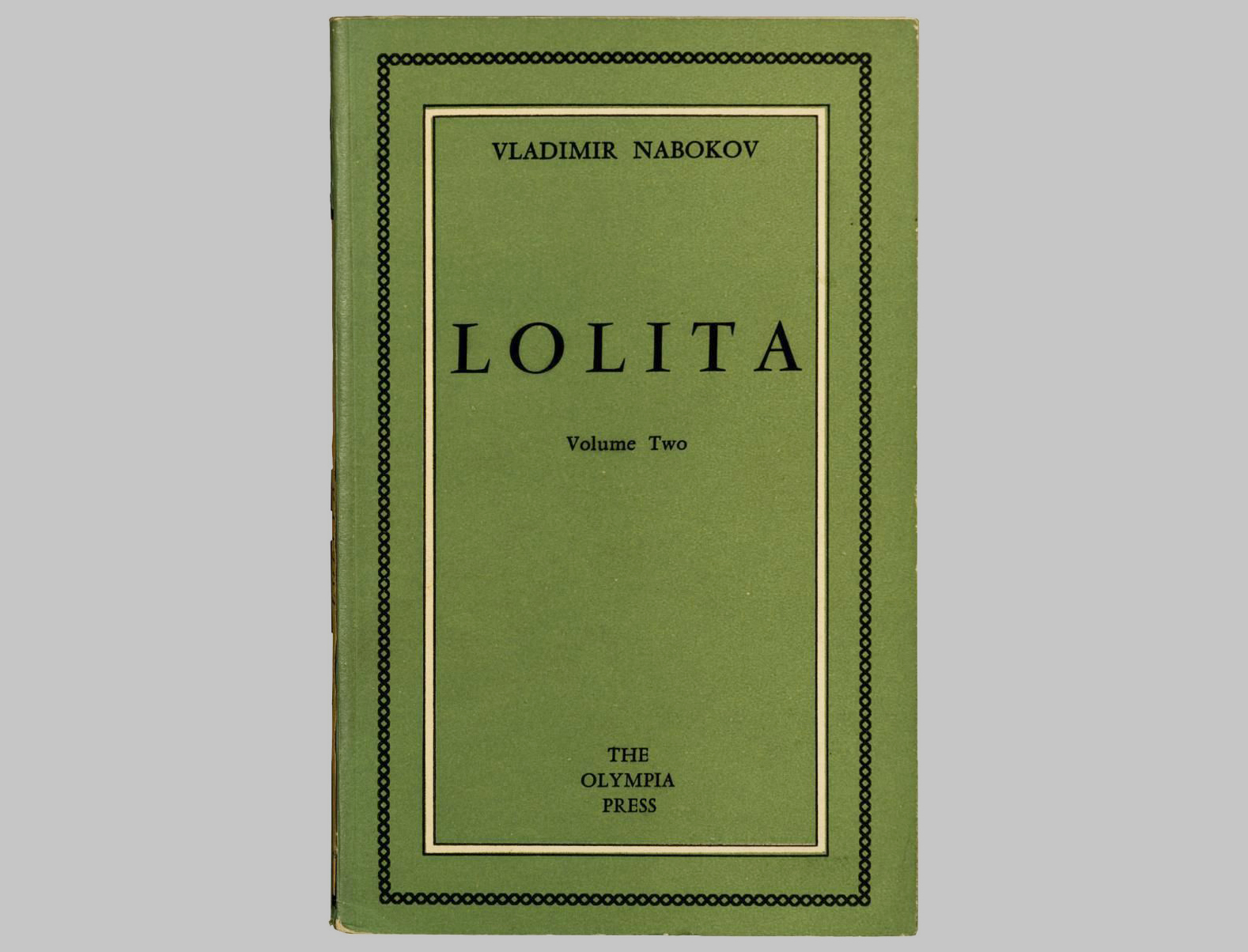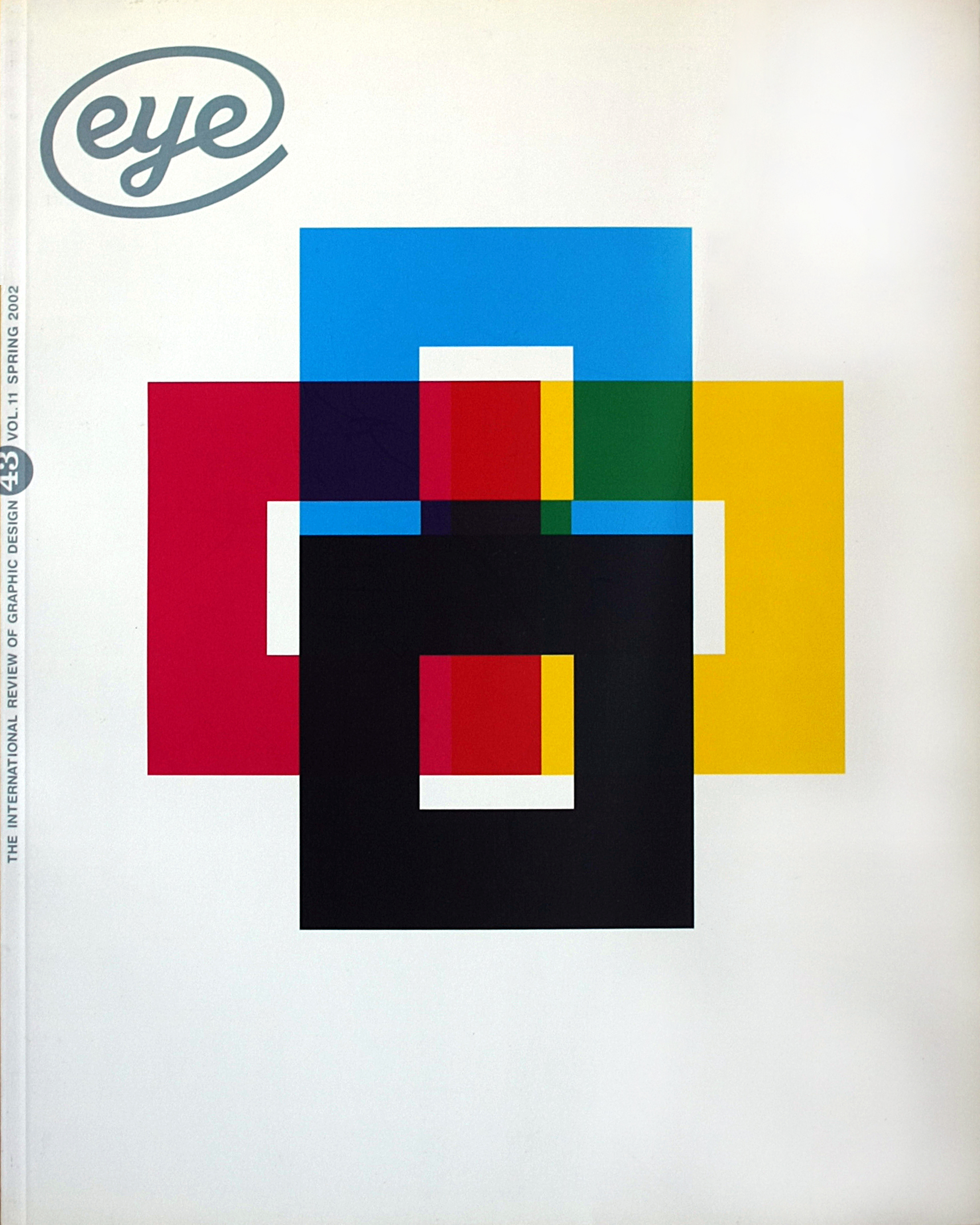Spring 2002
The look of Lolita
The author ‘emphatically opposed’ showing a girl on the cover. Most publishers ignored him. By Christopher Wilson

The function of a book jacket is to catch the potential reader’s attention – usually in an instant, and amid the visual noise of its neighbours. This is often achieved by abbreviating the book’s contents to a single image that speaks on a greater scale about the book. But what happens when these criteria are forced on a book that resists all abbreviation?
Lolita, the most famous novel by Russian émigré author Vladimir Nabokov (1899-1977) is the ultimate test case. Not only is its structure synopsis-proof, but the novel carries with it a great deal of misleading baggage thanks to the controversy surrounding its first publication. Due to its complexity and the taboo aspects of its content, designers and publishers have continued to misrepresent the title, and have often ignored the author’s own wishes, which were stated clearly in 1958.
Before assessing how Lolita has fared in the jump from verbal to visual form, it is necessary to examine the raw material of the novel itself. In straightforward narrative terms, Lolita is the story of Paris-born Humbert Humbert’s fixation with Dolores Haze, a twelve-year-old girl whom he meets in 1947 while seeking lodgings in suburban America. Spotting her on the lawn of her widowed mother’s house, Humbert sees reincarnated the lost sweetheart of his boyhood: ‘It was the same child … The twenty-five years I had lived since then, tapered to a palpitating point, and vanished.?’ Humbert and the girl he calls ‘Lolita’ embark on a tour of America’s motels, and soon become sexually involved – at first with her naïve consent. She escapes Humbert’s obsessive rule, and the story deteriorates into tragedy before reaching us in the form of a confession written by Humbert in prison – allegedly composed in a single draft.
[1] Letter to Altagracia de Jannelli, 23 March 1935, reprinted in Vladimir Nabokov: Selected Letters 1940-1977. London: Weidenfeld & Nicolson, 1990 (Eds. Dmitri Nabokov and Matthew J. Bruccoli).
Nevertheless a synopsis of this kind cannot represent the substance of Lolita. A ‘Nabokov blurb’ is an oxymoron. Twenty years before Lolita’s publication, he wrote to his then agent regarding another, much simpler book: ‘I am afraid I cannot very well send you a synopsis … the quality of this novel is in the way the plot is treated and not in the plot itself. Besides I am very much against my books being judged by mere descriptions of their contents.’ [1]
First edition. Paris: Olympia Press, 1955.

STYLE AND STRUCTURE
[2] Quoted by John Updike, ‘Introduction’ to Nabokov’s Lectures on Literature (ed. Fredson Bowers). New York: Harcourt Brace and Company, 1980.
[3] and [4] Introduction to The Annotated Lolita, New York: Random House, 1981.
Nabokov’s students at Cornell University learnt that ‘Style and structure are the essence of a book; great ideas are hogwash’. [2] In the case of ‘ideas’ literature, individual sentences, verbal structures and even the characters themselves are mere props that help along the ‘message’ of the narrative. By contrast, Nabokov’s writing carries no easily digestible message, and to meddle with even a small section of Lolita’s text would be to wreck the pattern of the whole. In his annotated version of the novel, Alfred Appel Jr identifies the allusions Lolita makes on ‘literary, historical, mythological, Biblical, anatomical, zoological, botanical, and geographical’ levels, as well as ‘cross-references to identical or related allusions in other Nabokov works’. [3] Then there are the puzzles and traps that hint at their creator’s presence, and deliberately upset the reader’s desire to be told a believable story. The name of ‘Vivian Darkbloom’ (accomplice to Humbert’s adversary Clare Quilty) can be rearranged to spell out that of a certain Russian author; the odd address ‘58 Inchkeith Ave’ nods to Lolita’s ‘standing four feet ten [or fifty-eight inches] in one sock’ at the beginning of the story; the first and last syllables of the respective surnames of ‘tweedy and short haired Miss Lester and fadedly feminine Miss Fabian’ combine to reveal their sexual preference.
The result of all this for the reader is that, while in some places the words function as they would in a conventional story – we look through them into the narrative – more often the language turns opaque, and we realise that the real substance of the prose lies in the games being played on its surface. As Appel writes, ‘There are thus at least two “plots” in all of Nabokov’s fiction: the characters in the book, and the consciousness of the creator above it – the “real plot” which is visible in the “gaps” and “holes” in the narrative.’ [4] Nabokov built various time-delays into the pattern of Lolita, which render some aspects of that ‘real plot’ difficult to discern first time around. The book depends upon at least a second reading for its effect, and we begin to understand exactly why he was against his books being ‘judged by mere descriptions of their contents’.
Lolita was rejected on moral or legal grounds by four American publishers during 1954, and upon publication by the pornographically inclined Olympia Press in France the following year entered into a farce of bannings (not all of which were constitutional) and unbannings, along with controversy in England and Italy. Though Lolita has long been acknowledged as a classic of modern literature, the novel’s initial troubles still form a significant part of its phenomenon, and continue to influence both its marketing and design.
NABOKOV’S WISH LIST
[5] and [6] Letters to Walter J. Minton, 1 March and 23 April 1958, reprinted in Vladimir Nabokov: Selected Letters 1940-1977.
In 1958 the book finally found interest from an American publisher, G. P. Putnam’s Sons. Nabokov wrote that March to its president, Walter J. Minton, of his ideas for the cover: ‘Do you think it could be possible to find today in New York an artist who would not be influenced in his work by the general cartoonesque and primitivist style jacket illustration? Who would be capable of creating a romantic, delicately drawn, non-Freudian and non-juvenile, picture for Lolita (a dissolving remoteness, a soft American landscape, a nostalgic highway – that sort of thing)? There is one subject which I am emphatically opposed to: any kind of representation of a little girl.‘ [5]
These wishes were reiterated in a more insistent and pedantic letter to Minton the following month: ‘I want pure colors, melting clouds, accurately drawn details, a sunburst above a receding road with the light reflected in furrows and ruts, after rain. And no girls. If we cannot find that kind of artistic and virile painting, let us settle for an immaculate white jacket (rough texture paper instead of the usual glossy kind), with Lolita in bold black lettering.’ [6]
[7] Letter to Maurice Girodias, 18 July 1955, reprinted in Vladimir Nabokov: Selected Letters 1940-1977.
[8] ‘On a Book Entitled Lolita’, essay appended to Lolita, G. P. Putnam's Sons, 1958.
These statements say much about Nabokov’s reaction to the controversy surrounding Lolita. The ‘succès de scandale’ [7] he had hoped could be averted was upon him, and these jacket suggestions, in their restricting detail, seem designed to tie the hands of any artist who might try to interpret Lolita in his or her own way. Rather than requesting an image that is especially suited to the novel, Nabokov appears to be specifying a non-image. True, much of the story takes place on the highways of America, but the ‘dissolving remoteness’, ‘melting clouds’ and ‘light reflected in furrows and ruts’ of which he writes are oddly bland and unspecific by comparison with the beautiful images that spill out from Lolita, and which Nabokov called ‘the nerves of the novel’. [8]
[9] Fax to the author, 24 September 2001.
[10] ‘Philistines and Philistinism’ in Lectures on Russian Literature (ed. Fredson Bowers), New York: Harcourt Brace and Company, 1981.
Aside from the desire to avoid any further controversy, was there another reason why Nabokov was so keen that the cover should not depict ‘any kind of representation of a little girl’? I put this question to his son, Dmitri, who has controlled the Nabokov estate since the death of his mother Véra in 1991. Dmitri, who has translated many of his father’s works into English, replied simply that Vladimir ‘was wary of potential poshlust (which did occur)’. [9] Poshlism was defined by Nabokov in his lectures as ‘not only the obviously trashy but mainly the falsely important, the falsely beautiful, the falsely clever, the falsely attractive. To apply the deadly label of poshlism to something is not only an aesthetic judgment but also a moral indictment.’ [10] Perhaps daunted by the author’s choosiness over imagery, Putnam’s finally opted for a purely typographic cover, which Nabokov liked.
[11] Interview with the author, 20 September 2001.
Weidenfeld & Nicolson, who bought the British rights to Lolita in 1959, also took the type-only option. Art director Eric Ayers could not closely relate the jacket to the text because he had not read it: ‘Sometimes you would have a proof copy; the majority of times you would just have an editorial blurb. I discovered early on that it was a great mistake to read the book. It doesn’t help – in fact it puts up a barrier. Much better to work from the blurb, because you have the bones of the thing. You have to examine the whole area of the project, reduce it down to its elements, and then at that point recreate it, so that the person looking at the finished design sees the whole area that you started from.’ [11] He also pointed out that reading every title he was given would have been impractical in the face of impending deadlines – an aspect of book jacket design still pertinent today.
A PHOTOGRAPHIC SOLUTION
[12] Interview with the author, 16 May 2001.
In 2000 Penguin repackaged its Twentieth-Century Classics, whose covers, as art director Pascale Hutton explains, were formerly ‘very much picture-research-based. There was a culture of finding the right image, from the right time, of the right scene on page 232.’ [12]
A photographic solution would be in keeping with the bias of the new series, which Hutton felt should be ‘photography-based more than picture-researched. Although they’re classics, and of a certain time, I wanted to prove that you can dress them up with a fresh look and treat them in a very contemporary way.’ It was by no means certain, though, that the estate would see things that way, so the commissioning process was carried out covertly. ‘We wouldn’t ask for any advice or what they wanted; we would just come up with an image, send it to them and see if we could get approval.’
Hutton commissioned Virginia Woods-Jack, who already had experience in photographing young girls, to find a new Lolita. Neither art director nor photographer were aware of the writer’s meticulously detailed wishes for the book jacket – Hutton wryly wonders whether ‘he would have wanted a spot uv varnish’. In the light of Nabokov’s insistence on ‘no girls’, what do they think of their cover? Would they have approached the brief differently?
[13] Interview with the author, 7 March 2001.
‘He would probably see this as a complete defacement of his work,’ says Woods-Jack, ‘which obviously isn’t something that a photographer would want. There’s so much that you can get across without being blatant, which was why I tried shooting the girl blowing bubble gum: it’s just a simple thing that a child is doing, but because of the intonation of the whole book and everything that surrounds it, that immediately brings something to the image. I would probably have still wanted to include, if not a girl, then a reference to a girl.’ [13]
She points to the montage approach taken by the Douglas Brothers in response to Martin Amis’s writing as an example of cover design that comes alive as the reader engages with the book, rather than imposing a preconception at the outset: ‘It was only when you went back and looked at the cover, then there were all those little “memories” of what the book was about and the cover made sense. But they were graphically strong enough to make somebody pick them off the shelf in the first place. Marketing books is a very difficult thing to do, and the image has to be arresting.’
Hutton believes the designer’s distance from a book can be a positive thing. Had Nabokov’s preferences been known, she says, Penguin might still have overruled them. ‘If the author has power of approval over the cover, and doesn’t like it, then there’s not much we can do. But with all due respect to them, although they’ve written the book and are immersed in it, they don’t necessarily know what is better for it, and they don’t know about any issues connected to sales, marketing or design. They have to trust us on that.’ An author may have many ideas for appropriate cover imagery, but these may be far removed from the realities of what will work on the shelves. In such cases the designer’s position becomes that of mediator between the author, who knows the work inside out, and the public, who may as yet know nothing.
Fortunately for Penguin, the jacket was greeted by enthusiastic approval from Dmitri Nabokov. But if both this photograph and the Balthus painting that appeared on the preceding Twentieth-Century Classics Lolita cover are contrary to Vladimir Nabokov’s wishes, why didn't the estate veto them? As Dmitri says now, ‘Before his death in 1977 my father had softened his stand; I approach the question with a certain adaptability, and suspect VN would have approved the two covers you mention.’
CONCLUSION
Whether Lolita has been treated correctly on graphic terms depends on the criteria we apply to book cover design. The examples discussed above are not typical – the majority of jackets for the book do not even vaguely relate to the way Lolita’s appearance is described in the text.
If evidence of a thorough understanding of the intricacies of its structure is what we are looking for, then it is obvious that the book has not been well served by its cover images. Similarly, if loyalty to the author’s wishes is the main criterion, the book jackets are a failure. But there is something to be said for the ‘soundbite’ approach taken by Ayers and, to a lesser extent, by Woods-Jack. Armed with a full understanding of the novel’s many levels, a designer could be excused for feeling daunted by Lolita.
Pascale Hutton again: ‘We didn’t want to get too bogged down with all the details of getting the right clothes and the right scenery – you’d end up doing some kind of costume drama if you did that. It’s more about creating an atmosphere. But at the same time you can’t afford to get it wrong.’ It is left to the individual designer to strike the right balance between knowing and unknowing, and to decide whether the jacket should make an active effort to contribute something to the book (Penguin Classics), or humbly let the prose speak for itself (Eric Ayers).
Lolita is no less complex than other Nabokov works of the period. What separates it from the others, and is the reason for its mistreatment, is the fact that it at first glance appears to be fronted by something immediate, potentially controversial, and a magnet for visual clichés: the image of a sexually experienced, underage girl.
Christopher Wilson, designer, writer, London
With thanks to Eric Ayers (1921-2001), Phil Baines, Ian Beck, Ed Fella, Ellen Jacoby, Esther Johnson, Jeffrey Johnson, Paul Maliszewski, Alan Powers, Sigbjörn Ryo, Glenn Sjokvist, Nikki Smith, Anna South; and Marguerite Baux, Florence Callot and Emma Whitehair at Agnes B.
First published in Eye no. 43 vol. 11, 2002.
Eye is the world's most beautiful and collectable graphic design journal, published for professional designers, students and anyone interested in critical, informed writing about graphic design and visual culture. It is available from all good design bookshops and online at the Eye shop, where you can buy subscriptions and single issues.

